-
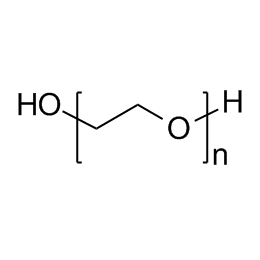 Poly(ethylene oxide), MW 100000 (PEO 100K)Catalog Number 06104
Poly(ethylene oxide), MW 100000 (PEO 100K)Catalog Number 06104Water-soluble polymer in a white, free flowing powder. Used to impart viscosity to and modify flow of aqueous solutions. See poly(ethylene glycol) for lower molecular weight analogs. Poly(ethylene glycol) has a broad molecular weight distribution ranging from~ 0.5x to 1.5x the values shown.
Soluble in: acetone, alcohol, chloroform, toluene, dichloromethane
PEO Contains 0.01% BHT, SiO2 1.5% max, alkaline earth oxide as CaO 0.5%,
-
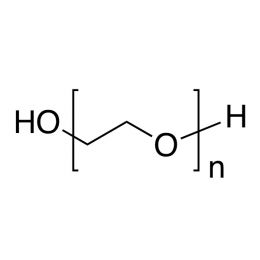 Poly(ethylene glycol) MW 2,000Catalog Number 25360
Poly(ethylene glycol) MW 2,000Catalog Number 25360Water-soluble, nonionic, relatively inert, liquids or solids. Confers slip and humectant properties to coatings. See poly(ethylene oxide) for higher molecular weights. The terms poly(ethylene glycol) and poly(ethylene oxide) refer to polymers which are chemically identical. Polymer chains are hydroxyl-terminated at both ends. At all except the lowest molecular weights poly(ethylene glycol) has a broad molecular weight distribution ranging from ~ 0.5x to 1.5x the values shown.
-
![Poly(ethylene glycol) [MW 1,450]](https://www.polysciences.com/media/catalog/product/cache/41caa8e834a03fb3ab31ba2c24269124/0/0/00679.jpg) Poly(ethylene glycol) [MW 1,450]Catalog Number 00679Inquire for availability.Phone: 1(800)523-2575Email: [email protected]
Poly(ethylene glycol) [MW 1,450]Catalog Number 00679Inquire for availability.Phone: 1(800)523-2575Email: [email protected]Water-soluble, nonionic, relatively inert, liquids or solids. Confers slip and humectant properties to coatings. See poly(ethylene oxide) for higher molecular weights. The terms poly(ethylene glycol) and poly(ethylene oxide) refer to polymers which are chemically identical. Polymer chains are hydroxyl-terminated at both ends. At all except the lowest molecular weights poly(ethylene glycol) has a broad molecular weight distribution ranging from ~ 0.5x to 1.5x the values shown.
PEG
-
![Poly(ethylene glycol) [MW 600]](https://www.polysciences.com/media/catalog/product/cache/41caa8e834a03fb3ab31ba2c24269124/0/0/00684.jpg) Poly(ethylene glycol) [MW 600]Catalog Number 00684
Poly(ethylene glycol) [MW 600]Catalog Number 00684Water-soluble, nonionic, relatively inert, liquids or solids. Confers slip and humectant properties to coatings. See poly(ethylene oxide) for higher molecular weights. The terms poly(ethylene glycol) and poly(ethylene oxide) refer to polymers which are chemically identical. Polymer chains are hydroxyl-terminated at both ends. At all except the lowest molecular weights poly(ethylene glycol) has a broad molecular weight distribution ranging from ~ 0.5x to 1.5x the values shown.
-
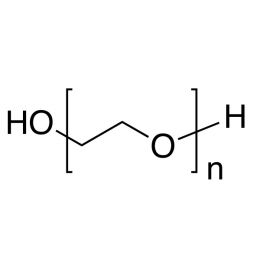 Poly(ethylene glycol), MW 400 (PEG 400)Catalog Number 01109
Poly(ethylene glycol), MW 400 (PEG 400)Catalog Number 01109Water-soluble, nonionic, relatively inert, liquids or solids. Confers slip and humectant properties to coatings. See poly(ethylene oxide) for higher molecular weights. The terms poly(ethylene glycol) and poly(ethylene oxide) refer to polymers which are chemically identical. Polymer chains are hydroxyl-terminated at both ends. At all except the lowest molecular weights poly(ethylene glycol) has a broad molecular weight distribution ranging from ~ 0.5x to 1.5x the values shown.
Soluble in: alcohol, acetone, chloroform, toluene, dichloromethane
-
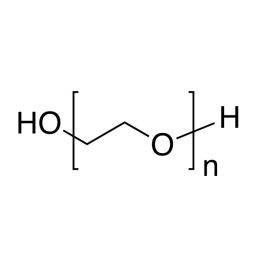 Poly(ethylene glycol), MW 3400, pharma grade (PEG 3400)Catalog Number 06102
Poly(ethylene glycol), MW 3400, pharma grade (PEG 3400)Catalog Number 06102Water-soluble, nonionic, relatively inert, liquids or solids. Confers slip and humectant properties to coatings. See poly(ethylene oxide) for higher molecular weights. The terms poly(ethylene glycol) and poly(ethylene oxide) refer to polymers which are chemically identical. Polymer chains are hydroxyl-terminated at both ends. At all except the lowest molecular weights poly(ethylene glycol) has a broad molecular weight distribution ranging from ~ 0.5x to 1.5x the values shown.
PEG
-
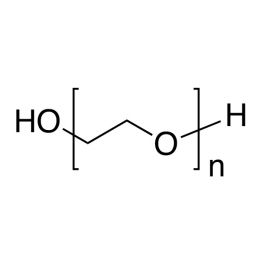 Poly(ethylene glycol), MW 7,500 (PEG 7500)Catalog Number 06103
Poly(ethylene glycol), MW 7,500 (PEG 7500)Catalog Number 06103Water-soluble, nonionic, relatively inert, liquids or solids. Confers slip and humectant properties to coatings. See poly(ethylene oxide) for higher molecular weights. The terms poly(ethylene glycol) and poly(ethylene oxide) refer to polymers which are chemically identical. Polymer chains are hydroxyl-terminated at both ends. At all except the lowest molecular weights poly(ethylene glycol) has a broad molecular weight distribution ranging from ~ 0.5x to 1.5x the values shown.
Soluble in: alcohol, acetone, chloroform, toluene, dichloromethane
PEG
-
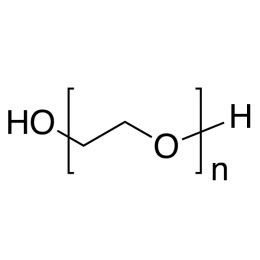 Poly(ethylene glycol), MW 10,000-16,000 (PEG 10K-16K)Catalog Number 22567
Poly(ethylene glycol), MW 10,000-16,000 (PEG 10K-16K)Catalog Number 22567Water-soluble, nonionic, relatively inert, liquids or solids. Confers slip and humectant properties to coatings. See poly(ethylene oxide) for higher molecular weights. The terms poly(ethylene glycol) and poly(ethylene oxide) refer to polymers which are chemically identical. Polymer chains are hydroxyl-terminated at both ends. At all except the lowest molecular weights poly(ethylene glycol) has a broad molecular weight distribution ranging from ~ 0.5x to 1.5x the values shown.
Soluble in: alcohol, acetone, chloroform, toluene, dichloromethane
PEG
-
![Poly(ethylene glycol) [MW 20,000]](https://www.polysciences.com/media/catalog/product/cache/41caa8e834a03fb3ab31ba2c24269124/2/2/22568.jpg) Poly(ethylene glycol) [MW 20,000]Catalog Number 22568
Poly(ethylene glycol) [MW 20,000]Catalog Number 22568Water-soluble, nonionic, relatively inert, liquids or solids. Confers slip and humectant properties to coatings. See poly(ethylene oxide) for higher molecular weights. The terms poly(ethylene glycol) and poly(ethylene oxide) refer to polymers which are chemically identical. Polymer chains are hydroxyl-terminated at both ends. At all except the lowest molecular weights poly(ethylene glycol) has a broad molecular weight distribution ranging from ~ 0.5x to 1.5x the values shown.
Soluble in: alcohol, acetone, chloroform, toluene, dichloromethane
PEG
-
![Poly(ethylene glycol) [MW 8000; pharma grade]](https://www.polysciences.com/media/catalog/product/cache/41caa8e834a03fb3ab31ba2c24269124/1/7/17243.jpg) Poly(ethylene glycol) [MW 8000; pharma grade]Catalog Number 17243
Poly(ethylene glycol) [MW 8000; pharma grade]Catalog Number 17243Water-soluble, nonionic, relatively inert, liquids or solids. Confers slip and humectant properties to coatings. See poly(ethylene oxide) for higher molecular weights. The terms poly(ethylene glycol) and poly(ethylene oxide) refer to polymers which are chemically identical. Polymer chains are hydroxyl-terminated at both ends. At all except the lowest molecular weights poly(ethylene glycol) has a broad molecular weight distribution ranging from ~ 0.5x to 1.5x the values shown.
PEG
-
![Poly(ethylene glycol) [MW 1,000]](https://www.polysciences.com/media/catalog/product/cache/41caa8e834a03fb3ab31ba2c24269124/0/0/00682.jpg) Poly(ethylene glycol) [MW 1,000]Catalog Number 00682
Poly(ethylene glycol) [MW 1,000]Catalog Number 00682Water-soluble, nonionic, relatively inert, liquids or solids. Confers slip and humectant properties to coatings. See poly(ethylene oxide) for higher molecular weights. The terms poly(ethylene glycol) and poly(ethylene oxide) refer to polymers which are chemically identical. Polymer chains are hydroxyl-terminated at both ends. At all except the lowest molecular weights poly(ethylene glycol) has a broad molecular weight distribution ranging from ~ 0.5x to 1.5x the values shown.
Soluble in: alcohol, acetone, chloroform, toluene, dichloromethane
-
![Poly(ethylene oxide) [MW 1,000,000]](https://www.polysciences.com/media/catalog/product/cache/41caa8e834a03fb3ab31ba2c24269124/2/1/21295.jpg) Poly(ethylene oxide) [MW 1,000,000]Catalog Number 21295
Poly(ethylene oxide) [MW 1,000,000]Catalog Number 21295Water-soluble polymer in a white, free flowing powder. Used to impart viscosity to and modify flow of aqueous solutions. See poly(ethylene glycol) for lower molecular weight analogs. Poly(ethylene glycol) has a broad molecular weight distribution ranging from~ 0.5x to 1.5x the values shown.
Soluble in: acetone, alcohol, chloroform, toluene, dichloromethane
PEO
-
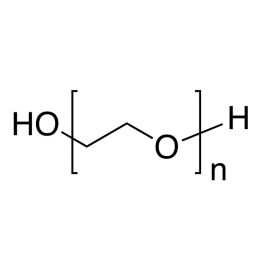 Poly(ethylene oxide), MW 200,000 (PEO 200000)Catalog Number 17503
Poly(ethylene oxide), MW 200,000 (PEO 200000)Catalog Number 17503Water-soluble polymer in a white, free flowing powder. Used to impart viscosity to and modify flow of aqueous solutions. See poly(ethylene glycol) for lower molecular weight analogs. Poly(ethylene glycol) has a broad molecular weight distribution ranging from ~0.5x to 1.5x the values shown.
Soluble in: acetone, alcohol, chloroform, toluene, dichloromethane
PEO
-
![Poly(ethylene oxide) [MW 4,000,000]](https://www.polysciences.com/media/catalog/product/cache/41caa8e834a03fb3ab31ba2c24269124/0/4/04030.jpg) Poly(ethylene oxide) [MW 4,000,000]Catalog Number 04030
Poly(ethylene oxide) [MW 4,000,000]Catalog Number 04030Water-soluble polymer in a white, free flowing powder. Used to impart viscosity to and modify flow of aqueous solutions. See poly(ethylene glycol) for lower molecular weight analogs. Poly(ethylene glycol) has a broad molecular weight distribution ranging from~ 0.5x to 1.5x the values shown.
-
![Poly(ethylene oxide) [MW 5,000,000]](https://www.polysciences.com/media/catalog/product/cache/41caa8e834a03fb3ab31ba2c24269124/0/4/04031.jpg) Poly(ethylene oxide) [MW 5,000,000]Catalog Number 04031
Poly(ethylene oxide) [MW 5,000,000]Catalog Number 04031Water-soluble polymer in a white, free flowing powder. Used to impart viscosity to and modify flow of aqueous solutions.
See poly(ethylene glycol) for lower molecular weight analogs. Poly(ethylene glycol) has a broad molecular weight distribution ranging from~ 0.5x to 1.5x the values shown.
Soluble in: acetone, alcohol, chloroform, toluene, dichloromethane
PEG
-
![Poly(ethylene oxide) [MW 600,000]](https://www.polysciences.com/media/catalog/product/cache/41caa8e834a03fb3ab31ba2c24269124/0/6/06106.jpg) Poly(ethylene oxide) [MW 600,000]Catalog Number 06106
Poly(ethylene oxide) [MW 600,000]Catalog Number 06106Water-soluble polymer in a white, free flowing powder. Used to impart viscosity to and modify flow of aqueous solutions. See poly(ethylene glycol) for lower molecular weight analogs. Poly(ethylene glycol) has a broad molecular weight distribution ranging from~ 0.5x to 1.5x the values shown.
Soluble in: acetone, alcohol, chloroform, toluene, dichloromethane
PEO
-
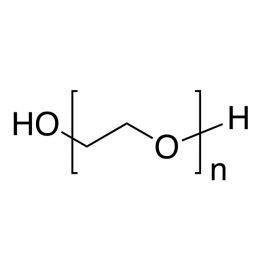 Poly(ethylene oxide), MW 8,000,000 (PEO 8000000)Catalog Number 21296Inquire for availability.Phone: 1(800)523-2575Email: [email protected]
Poly(ethylene oxide), MW 8,000,000 (PEO 8000000)Catalog Number 21296Inquire for availability.Phone: 1(800)523-2575Email: [email protected]Water-soluble polymer in a white, free flowing powder. Used to impart viscosity to and modify flow of aqueous solutions. See poly(ethylene glycol) for lower molecular weight analogs. Poly(ethylene glycol) has a broad molecular weight distribution ranging from~ 0.5x to 1.5x the values shown.
Soluble in: acetone, alcohol, chloroform, toluene, dichloromethane
PEO
Poly(ethylene glycol) and Poly(ethylene oxide)
